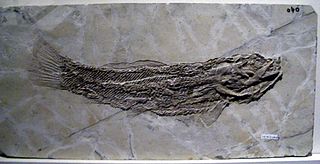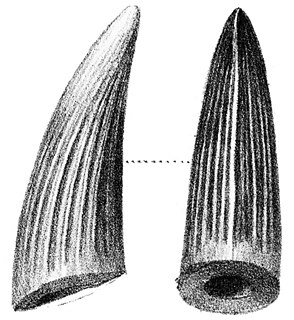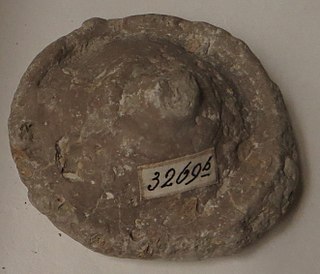
The Amiiformes order of fish has only one extant species, the bowfin. These Amiiformes are found in the freshwater systems of North America, in the United States and parts of southern Canada. They live in freshwater streams, rivers, and swamps.

Karl Alfred Ritter von Zittel was a German palaeontologist best known for his Handbuch der Palaeontologie (1876–1880).

Titanosaurus is a dubious genus of sauropod dinosaurs, first described by Richard Lydekker in 1877. It is known from the Maastrichtian Lameta Formation of India and possibly also the Maastrichtian Marília Formation of Brazil.

Regnosaurus is a genus of herbivorous stegosaurian dinosaur that lived during the Early Cretaceous Period in what is now England.

Nuthetes is the name given to a dubious dromaeosaurid, genus of theropod dinosaur, known only from fossil teeth and jaw fragments found in rocks of the middle Berriasian age in the Cherty Freshwater Member of the Lulworth Formation in England. As a dromaeosaurid, Nuthetes would have been a small predator.

Suchosaurus is a spinosaurid dinosaur from Cretaceous England and Portugal, originally believed to be a genus of crocodile. The type material, consisting of teeth, was used by British palaeontologist Richard Owen to name the species S. cultridens in 1841. Later in 1897, French palaeontologist Henri-Émile Sauvage named a second species, S. girardi, based on two fragments from the mandible and one tooth discovered in Portugal. Suchosaurus is possibly a senior synonym of the contemporary spinosaurid Baryonyx, but is usually considered a dubious name due to the paucity of its remains, and is considered an indeterminate baryonychine. In the Wadhurst Clay Formation of what is now southern England, Suchosaurus lived alongside other dinosaurs, as well as plesiosaurs, mammals, and crocodyliforms.

Aspidoceras is an extinct ammonoid cephalopod genus belonging to the family Aspidoceratidae.

Protostegidae is a family of extinct marine turtles that lived during the Cretaceous period. The family includes some of the largest sea turtles that ever existed. The largest, Archelon, had a head one metre (39 in) long. Like most sea turtles, they had flattened bodies and flippers for front appendages; protostegids had minimal shells like leatherback turtles of modern times.

Scanisaurus is a dubious genus of plesiosaur that lived in what is now Sweden and Russia during the Campanian stage of the Late Cretaceous period. The name Scanisaurus means "Skåne lizard", Skåne being the southernmost province of Sweden, where a majority of the fossils referred to the genus have been recovered. The genus contains one species, S. nazarowi, described in 1911 by Nikolay Bogolyubov as a species of Cimoliasaurus based on a single vertebral centrum discovered near Orenburg, Russia.

Exogyra is an extinct genus of fossil marine oysters in the family Gryphaeidae, the foam oysters or honeycomb oysters. These bivalves grew cemented by the more cupped left valve. The right valve is flatter, and the beak is curved to one side. Exogyra lived on solid substrates in warm seas during the Jurassic and Cretaceous periods.
Diplosaurus is an extinct genus of goniopholidid mesoeucrocodylian. Fossils have been found from the Western United States and range from Late Jurassic to Early Cretaceous in age. The genus was first named and described in a paper written in 1877 by Othniel Charles Marsh. The generic name, derived from Greek διπλόος, diploos, "double", probably refers to the "biconcave vertebrae" Marsh mentions as a distinctive trait compared to modern forms. The type species is Diplosaurus felix. In 1890 Karl Alfred von Zittel recombined this with Goniopholis into a Goniopholis felix, but today this is generally rejected.

Stoycho Vassilev Breskovski was a Bulgarian paleontologist.

Barremitinae is a subfamily belonging to the Ammonoidea subclass. Whorl section in this group ranges from more or less circular through rectangular to oxyconic. Ribbing, if present, is weak. Suture is relatively simple, without markedly retracted suspensive lobe.

Peronidella is an extinct genus of Calcareous sponges found in marine sedimentary rocks dated between the Devonian and the Cretaceous periods.

Palaeovaranus is an extinct genus of varanoid lizards from the Late Eocene of France and Germany. It contains two species, Palaeovaranus cayluxensis and Palaeovaranus giganteus. The genus was first named by Henri Filhol in 1877, but he had named the species Palaeovaranus cayluxi earlier as Palaeosaurus cayluxi in 1873, and as Necrosaurus cuxleyi in 1876 after it was discovered that Palaeosaurus was preoccupied. However, he failed to provide any kind of valid description, which renders Karl Alfred Ritter von Zittel's 1887 description of the taxon as the valid authority on its validity. Despite this, the name Necrosaurus was widely used in the literature afterwards.

Raphidonema is an extinct genus of calcareous sponges.

Siphoniidae is an extinct family of sea sponges belonging to the class Demospongiae.

Cupulospongia is an extinct genus of sea sponges from the Cretaceous of France.
Protomonaxonida is an extinct order of sea sponges. It is a paraphyletic group gathering the most ancient species from the Burgess Shale to modern sponges.

Coeloptychium is an extinct genus of lychniscosidan hexasterophoran sea sponge which has often been used as an index fossil. Its remains have been found in Cretaceous sediments in Germany, Belgium, France and the UK. Coeloptyhcium is best preserved in Campanian sediments in Germany. The type species, C. agaricoides, was named in 1826.


















